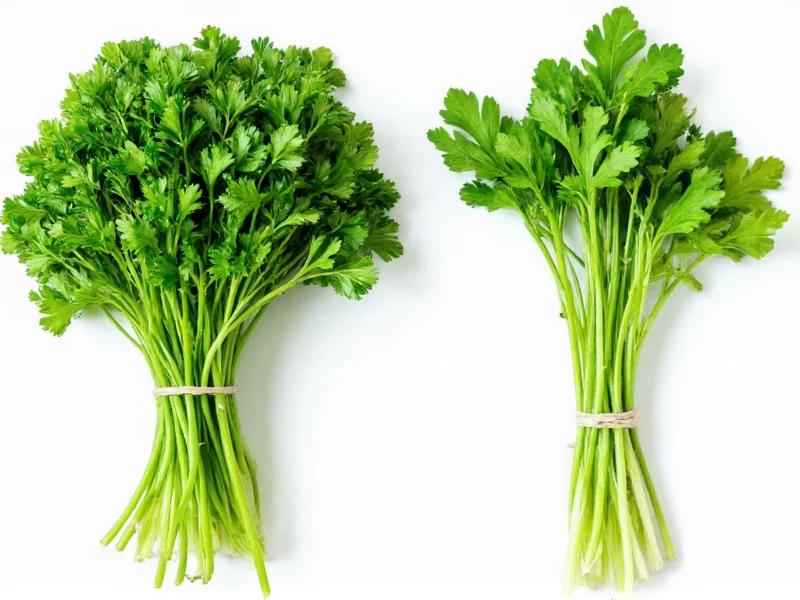Visual Identification: Spotting the Difference at a Glance
When standing side by side in the produce section, parsley and cilantro present clear visual distinctions. Parsley comes in two main varieties: curly parsley with ruffled, dark green leaves, and Italian (flat-leaf) parsley with broader, flatter leaves that resemble celery tops. Cilantro, by contrast, has delicate, rounded leaves with scalloped edges that appear more feathery. The stems of cilantro are thinner and more fragile than parsley's sturdier stalks. When examining fresh bunches, cilantro typically displays a lighter, more yellowish-green hue compared to parsley's deeper emerald color.
| Characteristic | Parsley | Cilantro |
|---|---|---|
| Leaf Shape | Pointed, triangular (flat-leaf) or curly | Rounded, lacy with scalloped edges |
| Color | Bright to dark green | Lighter, yellowish-green |
| Stem Texture | Thicker, more rigid | Thinner, more delicate |
| Overall Appearance | More structured, uniform | Softer, more feathery |
Flavor Profiles: Understanding Taste Differences
The taste difference between parsley and cilantro creates the most significant culinary distinction. Parsley offers a mild, grassy flavor with subtle bitterness—perfect as a background note in dishes. Professional chefs often describe flat-leaf parsley as having a clean, fresh taste that complements rather than dominates. Cilantro, however, delivers a powerful citrus punch with lemony, peppery notes that can be polarizing. Approximately 20% of the population carries a genetic variation that makes cilantro taste like soap—a phenomenon directly related to olfactory receptor genes. This genetic difference explains why some people love cilantro while others find it unpalatable.
Botanical Classification and Growing Characteristics
Despite their visual similarities, parsley and cilantro belong to different botanical classifications within the Apiaceae family. Parsley (Petroselinum crispum) grows as a biennial plant typically harvested during its first year. Cilantro (Coriandrum sativum) completes its entire life cycle in one season, with the leaves (cilantro) and seeds (coriander) both used in cooking. Gardeners note that cilantro bolts quickly in warm weather, sending up flower stalks that produce coriander seeds, while parsley maintains leaf production longer under similar conditions. Both herbs prefer cool weather but cilantro particularly struggles in heat, making timing crucial for successful cultivation.
Culinary Applications and Substitution Guidance
Understanding when to use each herb prevents recipe disasters. Parsley serves as a versatile garnish and flavor enhancer in European and American cuisines—think tabbouleh, chimichurri, and as the finishing touch on roasted meats. Its mild flavor makes it suitable for both raw and cooked applications. Cilantro, essential in Latin American, Indian, and Southeast Asian cooking, brings vibrant freshness to salsas, curries, and pho. Crucially, these herbs aren't interchangeable: substituting parsley for cilantro in guacamole would lack the necessary citrus notes, while using cilantro in place of parsley in a delicate French sauce would overwhelm other flavors. When substitutions are necessary, consider basil or mint for cilantro's role, and celery leaves or chervil for parsley.
Storage and Shelf Life Considerations
Proper storage extends the usability of both herbs but requires slightly different approaches. For parsley, trim the stems and place in a glass of water (like flowers) covered loosely with a plastic bag in the refrigerator—this method maintains freshness for 1-2 weeks. Cilantro benefits from the same water storage technique but typically lasts only 5-7 days before wilting. Some chefs recommend washing and thoroughly drying cilantro before wrapping in paper towels and storing in an airtight container—a method that reduces moisture-related spoilage. Freezing either herb in oil preserves flavor for cooked dishes, though texture changes make them unsuitable for garnishes after thawing.
Nutritional Comparison
Both herbs offer impressive nutritional profiles with some notable differences. Per 100g serving, cilantro contains higher concentrations of vitamin K and potassium, while parsley significantly outperforms in vitamin C and iron content. Cilantro's volatile oils provide antioxidant benefits, particularly for digestive health, whereas parsley's apiol content supports kidney function. Neither herb contributes substantial calories, making them excellent additions to health-conscious cooking. The nutritional differences, while interesting, shouldn't drive substitution decisions—their flavor profiles remain the primary consideration for culinary applications.
Common Confusion Points and Practical Tips
Grocery store labeling inconsistencies cause frequent mix-ups between these herbs. In some regions, cilantro is labeled as "coriander leaf," creating confusion with the seeds. When shopping, examine leaf shape first—rounded leaves indicate cilantro, while pointed leaves suggest parsley. Smell provides the definitive test: crush a leaf between your fingers—cilantro emits a strong citrus aroma, while parsley offers a milder, grassier scent. For gardeners, remember that cilantro flowers produce edible seeds (coriander), whereas parsley flowers are less commonly utilized. When recipes specify "fresh herbs," always verify which herb will deliver the intended flavor profile rather than making assumptions based on appearance alone.
Frequently Asked Questions
Can I substitute parsley for cilantro in salsa?
No, parsley lacks cilantro's distinctive citrus flavor essential to authentic salsa. The substitution would create a noticeably different taste profile. For closer results, consider using fresh mint or a combination of basil with a squeeze of lime juice.
Why does cilantro taste like soap to some people?
Approximately 20% of people have a genetic variation in olfactory receptor genes that causes them to perceive certain aldehydes in cilantro as soapy. This inherited trait explains why some individuals find cilantro unpalatable while others enjoy its citrus notes.
What's the difference between cilantro and coriander?
Cilantro refers to the fresh leaves of Coriandrum sativum, while coriander describes the dried seeds from the same plant. The entire plant produces different flavor compounds at various growth stages, resulting in distinct culinary applications for leaves versus seeds.
Which herb lasts longer in the refrigerator?
Parsley generally maintains freshness longer than cilantro. When stored properly in water with a loose plastic cover, parsley typically lasts 1-2 weeks, while cilantro usually wilts within 5-7 days due to its more delicate leaf structure and higher moisture content.











 浙公网安备
33010002000092号
浙公网安备
33010002000092号 浙B2-20120091-4
浙B2-20120091-4